Assessment of the Number of Valid Observations and Diurnal Changes in Chl-a for GOCI: Highlights for Geostationary Ocean Color Missions
Abstract
:1. Introduction
- Compare the daily percentages of valid observations (DPVOs) of Chl-a between MODISA and hourly and daily GOCI measurements and assess the diurnal changes in ocean color products at different locations;
- Demonstrate how differences in satellite orbits, observational frequencies and data processing methods could impact the data coverage and ocean color measurements;
- Discuss how the results of this study could be used to help both mission plan of future geostationary ocean color missions and associated algorithm development.
2. Data and Methods
2.1. Datasets and Preprocessing
2.2. Estimation of the DPVOs
2.3. Analysis of Diurnal Changes in Chl-a
3. Results and Discussion
3.1. Comparison of DPVOs between Different Satellite Missions and Observational Frequencies
3.2. Diurnal Changes in GOCI-Derived Chl-a
3.3. Factors Leading to Discrepancies in the DPVOs
3.4. Interpretation of the Diurnal Changes in GOCI Chl-a Retrievals
3.5. Implications for Future Geostationary Ocean Color Missions
4. Conclusions
Author Contributions
Funding
Conflicts of Interest
References
- McClain, C.R. A decade of satellite ocean color observations. Annu. Rev. Mar. Sci. 2009, 1, 19–42. [Google Scholar] [CrossRef] [Green Version]
- Yoder, J.; Kennelly, M. What Have We Learned About Ocean Variability from Satellite Ocean Color Imagers? Oceanography 2006, 19, 152–171. [Google Scholar] [CrossRef]
- Feng, L.; Hu, C. Comparison of Valid Ocean Observations Between MODIS Terra and Aqua Over the Global Oceans. IEEE Trans. Geosci. Remote Sens. 2015, 54, 1575–1585. [Google Scholar] [CrossRef]
- Arnone, R.; Vandermuelen, R.; Soto, I.; Ladner, S.; Ondrusek, M.; Yang, H. Diurnal changes in ocean color sensed in satellite imagery. J. Appl. Remote Sens. 2017, 11, 32406. [Google Scholar] [CrossRef] [Green Version]
- Lou, X.; Hu, C. Diurnal changes of a harmful algal bloom in the East China Sea: Observations from GOCI. Remote Sens. Environ. 2014, 140, 562–572. [Google Scholar] [CrossRef]
- Son, Y.B.; Choi, B.-J.; Kim, Y.H.; Park, Y.-G. Tracing floating green algae blooms in the Yellow Sea and the East China Sea using GOCI satellite data and Lagrangian transport simulations. Remote Sens. Environ. 2015, 156, 21–33. [Google Scholar] [CrossRef]
- Qi, L.; Hu, C.; Visser, P.M.; Ma, R. Diurnal changes of cyanobacteria blooms in Taihu Lake as derived from GOCI observations. Limnol. Oceanogr. 2018, 63, 1711–1726. [Google Scholar] [CrossRef] [Green Version]
- Jiang, L.; Wang, M. Diurnal Currents in the Bohai Sea Derived from the Korean Geostationary Ocean Color Imager. IEEE Trans. Geosci. Remote Sens. 2016, 55, 1–14. [Google Scholar] [CrossRef]
- Park, K.-A.; Lee, M.-S.; Park, J.-E.; Ullman, D.; Cornillon, P.C.; Park, Y.-J. Surface currents from hourly variations of suspended particulate matter from Geostationary Ocean Color Imager data. Int. J. Remote Sens. 2018, 39, 1929–1949. [Google Scholar] [CrossRef] [Green Version]
- Pan, Y.; Shen, F.; Wei, X. Fusion of Landsat-8/OLI and GOCI Data for Hourly Mapping of Suspended Particulate Matter at High Spatial Resolution: A Case Study in the Yangtze (Changjiang) Estuary. Remote Sens. 2018, 10, 158. [Google Scholar] [CrossRef] [Green Version]
- Yan, Y.; Huang, K.; Shao, D.; Xu, Y.; Gu, W. Monitoring the Characteristics of the Bohai Sea Ice Using High-Resolution Geostationary Ocean Color Imager (GOCI) Data. Sustainability 2019, 11, 777. [Google Scholar] [CrossRef] [Green Version]
- Yan, Y.; Uotila, P.; Huang, K.; Gu, W. Variability of sea ice area in the Bohai Sea from 1958 to 2015. Sci. Total. Environ. 2020, 709, 136164. [Google Scholar] [CrossRef] [PubMed]
- Murakami, H. Ocean Color Estimation by Himawari-8/Ahi. SPIE Asia-Pac. Remote Sens. SPIE 2016, 9878. [Google Scholar] [CrossRef]
- Chen, X.; Shang, S.; Lee, Z.; Qi, L.; Yan, J.; Li, Y. High-frequency observation of floating algae from AHI on Himawari-8. Remote Sens. Environ. 2019, 227, 151–161. [Google Scholar] [CrossRef]
- Hu, C.; Feng, L. GOES Imager Shows Diurnal Changes of a Trichodesmium erythraeum Bloom on the West Florida Shelf. IEEE Geosci. Remote Sens. Lett. 2014, 11, 1428–1432. [Google Scholar] [CrossRef]
- Yang, C.-S.; Song, J.-H. Geometric performance evaluation of the Geostationary Ocean Color Imager. Ocean Sci. J. 2012, 47, 235–246. [Google Scholar] [CrossRef]
- Ryu, J.-H.; Han, H.-J.; Cho, S.; Park, Y.-J.; Ahn, Y.-H. Overview of geostationary ocean color imager (GOCI) and GOCI data processing system (GDPS). Ocean Sci. J. 2012, 47, 223–233. [Google Scholar] [CrossRef]
- Fishman, J.; Iraci, L.T.; Al-Saadi, J.; Chance, K.; Chavez, F.; Chin, M.; Coble, P.; Davis, C.; Digiacomo, P.M.; Edwards, D.; et al. The United States’ Next Generation of Atmospheric Composition and Coastal Ecosystem Measurements: NASA’s Geostationary Coastal and Air Pollution Events (GEO-CAPE) Mission. Bull. Am. Meteorol. Soc. 2012, 93, 1547–1566. [Google Scholar] [CrossRef] [Green Version]
- Feng, L.; Hu, C.; Barnes, B.B.; Mannino, A.; Heidinger, A.; Strabala, K.; Iraci, L.T. Cloud and Sun-glint statistics derived from GOES and MODIS observations over the Intra-Americas Sea for GEO-CAPE mission planning. J. Geophys. Res. Atmos. 2017, 122, 1725–1745. [Google Scholar] [CrossRef]
- He, X.; Stamnes, K.; Bai, Y.; Li, W.; Wang, D. Effects of Earth curvature on atmospheric correction for ocean color remote sensing. Remote Sens. Environ. 2018, 209, 118–133. [Google Scholar] [CrossRef]
- King, M.D.; Ackerman, S.; Hubanks, P.A.; Platnick, S.; Menzel, W.P. Spatial and Temporal Distribution of Clouds Observed by MODIS Onboard the Terra and Aqua Satellites. IEEE Trans. Geosci. Remote Sens. 2013, 51, 3826–3852. [Google Scholar] [CrossRef]
- He, X.; Bai, Y.; Pan, D.; Huang, N.; Dong, X.; Chen, J.; Chen, C.-T.A.; Cui, Q. Using geostationary satellite ocean color data to map the diurnal dynamics of suspended particulate matter in coastal waters. Remote Sens. Environ. 2013, 133, 225–239. [Google Scholar] [CrossRef]
- Choi, J.-K.; Min, J.-E.; Noh, J.H.; Han, T.-H.; Yoon, S.; Park, Y.J.; Moon, J.-E.; Ahn, J.-H.; Ahn, S.-M.; Park, J.-H. Harmful algal bloom (HAB) in the East Sea identified by the Geostationary Ocean Color Imager (GOCI). Harmful Algae 2014, 39, 295–302. [Google Scholar] [CrossRef]
- Kim, H.; Son, Y.B.; Jo, Y.-H. Hourly Observed Internal Waves by Geostationary Ocean Color Imagery in the East/Japan Sea. J. Atmospheric Ocean. Technol. 2018, 35, 609–617. [Google Scholar] [CrossRef]
- Concha, J.; Mannino, A.; Franz, B.A.; Kim, W. Uncertainties in the Geostationary Ocean Color Imager (GOCI) Remote Sensing Reflectance for Assessing Diurnal Variability of Biogeochemical Processes. Remote Sens. 2019, 11, 295. [Google Scholar] [CrossRef] [Green Version]
- Neveux, J.; Dupouy, C.; Blanchot, J.; Le Bouteiller, A.; Landry, M.R.; Brown, S.L. Diel Dynamics of Chlorophylls in High-Nutrient, Low-Chlorophyll Waters of the Equatorial Pacific (180°): Interactions of Growth, Grazing, Physiological Responses, and Mixing. J. Geophys. Res. Oceans 2003, 108, C12. [Google Scholar] [CrossRef] [Green Version]
- MacIntyre, H.; Kana, T.M.; Anning, T.; Geider, R.J. Photoacclimation of Photosynthesis Irradiance Response Curves and Photosynthetic Pigments in Microalgae and Cyanobacteria. J. Phycol. 2002, 38, 17–38. [Google Scholar] [CrossRef] [Green Version]
- Mercado, J.M.; Ramírez, T.; Cortés, D.; Sebastián, M.; Reul, A.; Bautista, B. Diurnal changes in the bio-optical properties of the phytoplankton in the Alborán Sea (Mediterranean Sea). Estuarine Coast. Shelf Sci. 2006, 69, 459–470. [Google Scholar] [CrossRef]
- Tang, J.; Wang, X.; Song, Q.; Li, T.; Chen, J.; Huang, H.; Ren, J. The Statistic Inversion Algorithms of Water Constituents for the Huanghai Sea and the East China Sea. Acta Oceanologica Sinica 2004, 23, 617–626. [Google Scholar]
- Otten, T.G.; Xu, H.; Qin, B.; Zhu, G.; Paerl, H.W. Spatiotemporal Patterns and Ecophysiology of ToxigenicMicrocystisBlooms in Lake Taihu, China: Implications for Water Quality Management. Environ. Sci. Technol. 2012, 46, 3480–3488. [Google Scholar] [CrossRef]
- Carlson, R.E. A trophic state index for lakes. Limnol. Oceanogr. 1977, 22, 361–369. [Google Scholar] [CrossRef] [Green Version]
- Kim, W.; Moon, J.-E.; Park, Y.-J.; Ishizaka, J. Evaluation of chlorophyll retrievals from Geostationary Ocean Color Imager (GOCI) for the North-East Asian region. Remote Sens. Environ. 2016, 184, 482–495. [Google Scholar] [CrossRef]
- Hu, C.; Lee, Z.; Franz, B. Chlorophyll Aalgorithms for Oligotrophic Oceans: A Novel Approach Based on Three-Band Reflectance Difference. J. Geophys. Res. Oceans 2012, 117. [Google Scholar] [CrossRef] [Green Version]
- O’Reilly, J.E.; Maritorena, S.; Mitchell, B.G.; Carder, K.L.; Garver, S.A.; Kahru, M.; McClain, C.; Siegel, D.A. Ocean color chlorophyll algorithms for SeaWiFS. J. Geophys. Res. Space Phys. 1998, 103, 24937–24953. [Google Scholar] [CrossRef] [Green Version]
- Hooker, B.S.; Firestone, E.R.; Esaias, W.E.; Feldman, G.C.; Gregg, W.W.; Mcclain, C.R. An Overview of Seawifs and Ocean Color; NASA Goddard Space Flight Center: Greenbelt, MD, USA, 1992.
- Feng, L.; Hu, C. Cloud adjacency effects on top-of-atmosphere radiance and ocean color data products: A statistical assessment. Remote Sens. Environ. 2016, 174, 301–313. [Google Scholar] [CrossRef]
- Feng, L.; Hu, C. Land adjacency effects on MODIS Aqua top-of-atmosphere radiance in the shortwave infrared: Statistical assessment and correction. J. Geophys. Res. Oceans 2017, 122, 4802–4818. [Google Scholar] [CrossRef]
- Hu, C.; Feng, L.; Lee, Z.; Franz, B.; Bailey, S.W.; Werdell, P.J.; Proctor, C.W.; Werdell, J. Improving Satellite Global Chlorophyll a Data Products Through Algorithm Refinement and Data Recovery. J. Geophys. Res. Oceans 2019, 124, 1524–1543. [Google Scholar] [CrossRef]
- Le Borgne, R.; Rodier, M. Net zooplankton and the biological pump: A comparison between the oligotrophic and mesotrophic equatorial Pacific. Deep. Sea Res. Part II Top. Stud. Oceanogr. 1997, 44, 2003–2023. [Google Scholar] [CrossRef]
- Lohrenz, S.; Weidemann, A.D.; Tuel, M. Phytoplankton spectral absorption as influenced by community size structure and pigment composition. J. Plankton Res. 2003, 25, 35–61. [Google Scholar] [CrossRef]
- Babin, M.; Stramski, D.; Ferrari, G.M.; Claustre, H.; Bricaud, A.; Obolensky, G.; Hoepffner, N. Variations in the light absorption coefficients of phytoplankton, nonalgal particles, and dissolved organic matter in coastal waters around Europe. J. Geophys. Res. Space Phys. 2003, 108. [Google Scholar] [CrossRef]
- Fujiki, T.; Taguchi, S. Variability in chlorophyll a specific absorption coefficient in marine phytoplankton as a function of cell size and irradiance. J. Plankton Res. 2002, 24, 859–874. [Google Scholar] [CrossRef] [Green Version]
- Ding, K.; Gordon, H.R. Atmospheric correction of ocean-color sensors: Effects of the Earth’s curvature. Appl. Opt. 1994, 33, 7096. [Google Scholar] [CrossRef] [PubMed]
- Kim, W.; Ahn, J.-H.; Park, Y.-J. Correction of Stray-Light-Driven Interslot Radiometric Discrepancy (ISRD) Present in Radiometric Products of Geostationary Ocean Color Imager (GOCI). IEEE Trans. Geosci. Remote Sens. 2015, 53, 5458–5472. [Google Scholar] [CrossRef]
- Hu, C.; Feng, L.; Lee, Z.; Davis, C.O.; Mannino, A.; McClain, C.R.; Franz, B.A. Dynamic range and sensitivity requirements of satellite ocean color sensors: Learning from the past. Appl. Opt. 2012, 51, 6045–6062. [Google Scholar] [CrossRef] [Green Version]
- Lin, G.; Yang, Q.; Wang, Y.; Lin, W. Species Composition and Distribution Characteristics of Phytoplankton in Northern Sea of Fujian, China During Withdraw of Zhe-Min Coastal Current. Chin. J. Appl. Environ. Biol. 2012, 18, 411. [Google Scholar] [CrossRef]
- McClain, C.R.; Signorini, S.R.; Christian, J.R. Subtropical gyre variability observed by ocean-color satellites. Deep. Sea Res. Part II Top. Stud. Oceanogr. 2004, 51, 281–301. [Google Scholar] [CrossRef] [Green Version]
- Rykaczewski, R.R.; Dunne, J.P. A measured look at ocean chlorophyll trends. Nature 2011, 472, E5–E6. [Google Scholar] [CrossRef] [PubMed]
- Zhang, C.; Shang, S.; Chen, D.; Shang, S. Short-Term Variability of the Distribution of Zhe-Min Coastal Water and Wind Forcing During Winter Monsoon in the Taiwan Strait. J. Remote Sens. 2005, 9, 452. [Google Scholar]
- Gordon, H.R. Atmospheric correction of ocean color imagery in the Earth Observing System era. J. Geophys. Res. Space Phys. 1997, 102, 17081–17106. [Google Scholar] [CrossRef]
- Gordon, H.R.; Wang, M. Retrieval of water-leaving radiance and aerosol optical thickness over the oceans with SeaWiFS: A preliminary algorithm. Appl. Opt. 1994, 33, 443. [Google Scholar] [CrossRef]
- Wang, M.; Ahn, J.-H.; Jiang, L.; Shi, W.; Son, S.; Park, Y.-J.; Ryu, J.-H. Ocean color products from the Korean Geostationary Ocean Color Imager (GOCI). Opt. Express 2013, 21, 3835–3849. [Google Scholar] [CrossRef] [PubMed]
- Maritorena, S.; Siegel, D.A.; Peterson, A.R. Optimization of a semianalytical ocean color model for global-scale applications. Appl. Opt. 2002, 41, 2705–2714. [Google Scholar] [CrossRef] [PubMed]
- Bailey, S.W.; Werdell, P.J. A multi-sensor approach for the on-orbit validation of ocean color satellite data products. Remote Sens. Environ. 2006, 102, 12–23. [Google Scholar] [CrossRef]
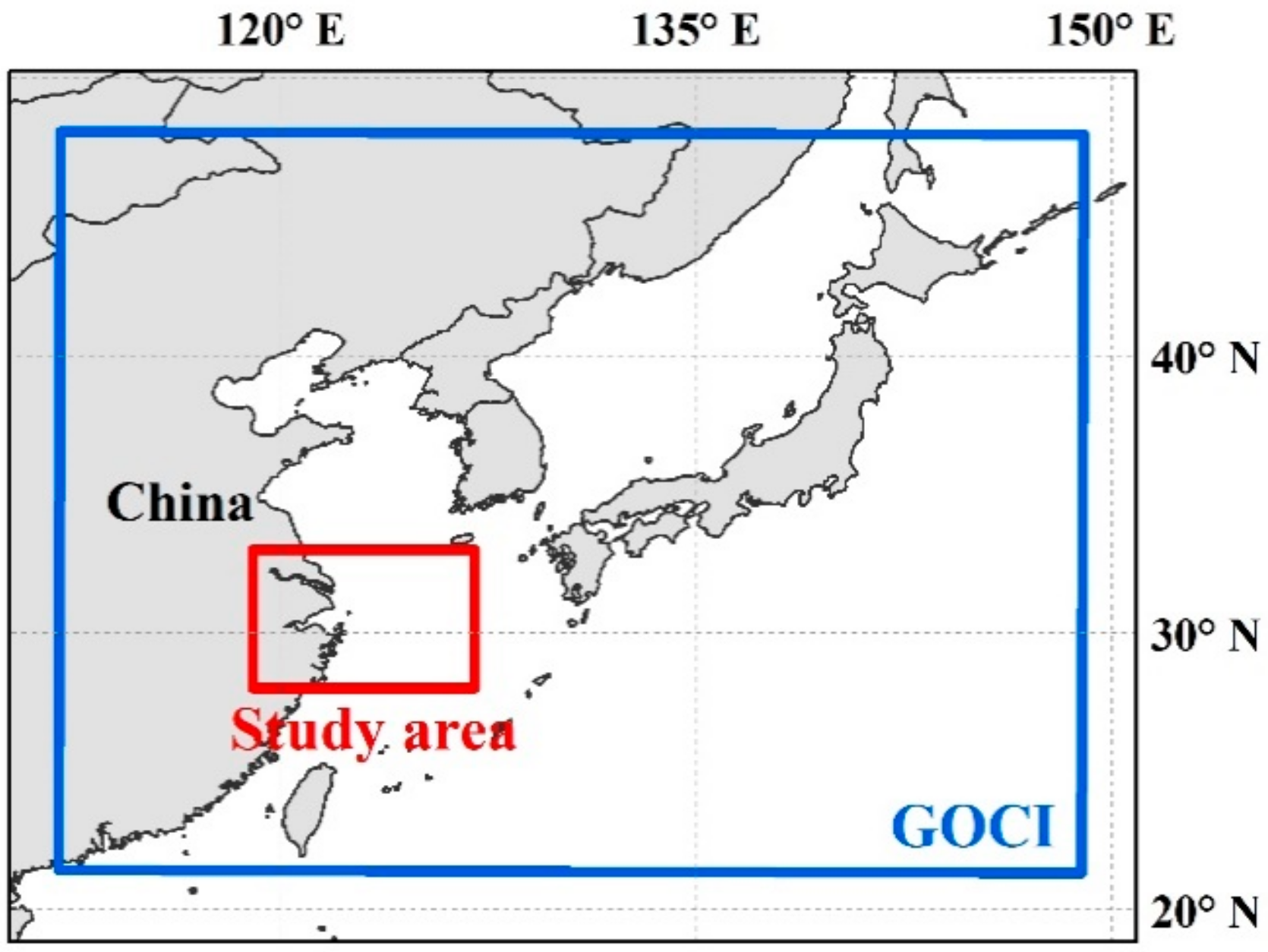
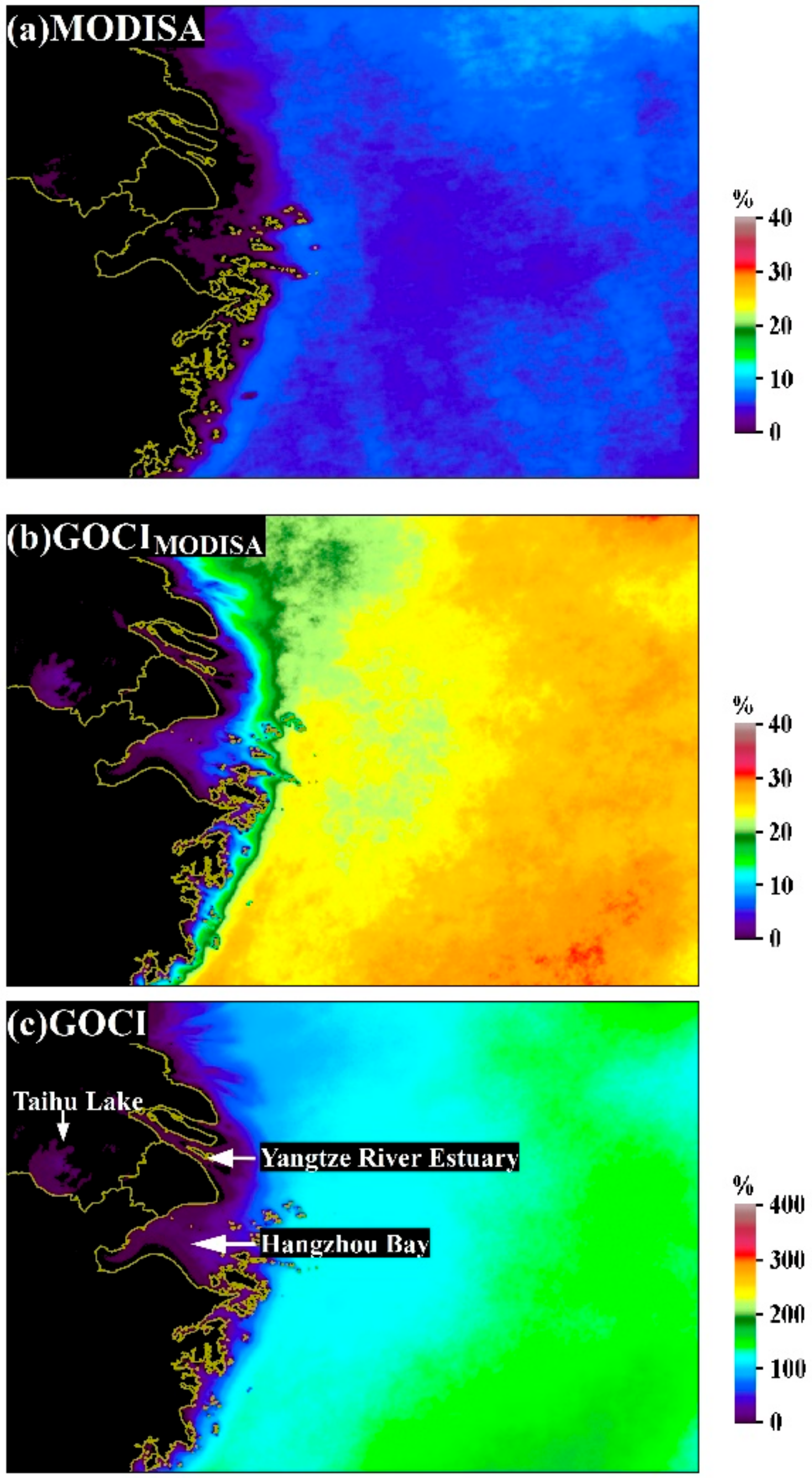
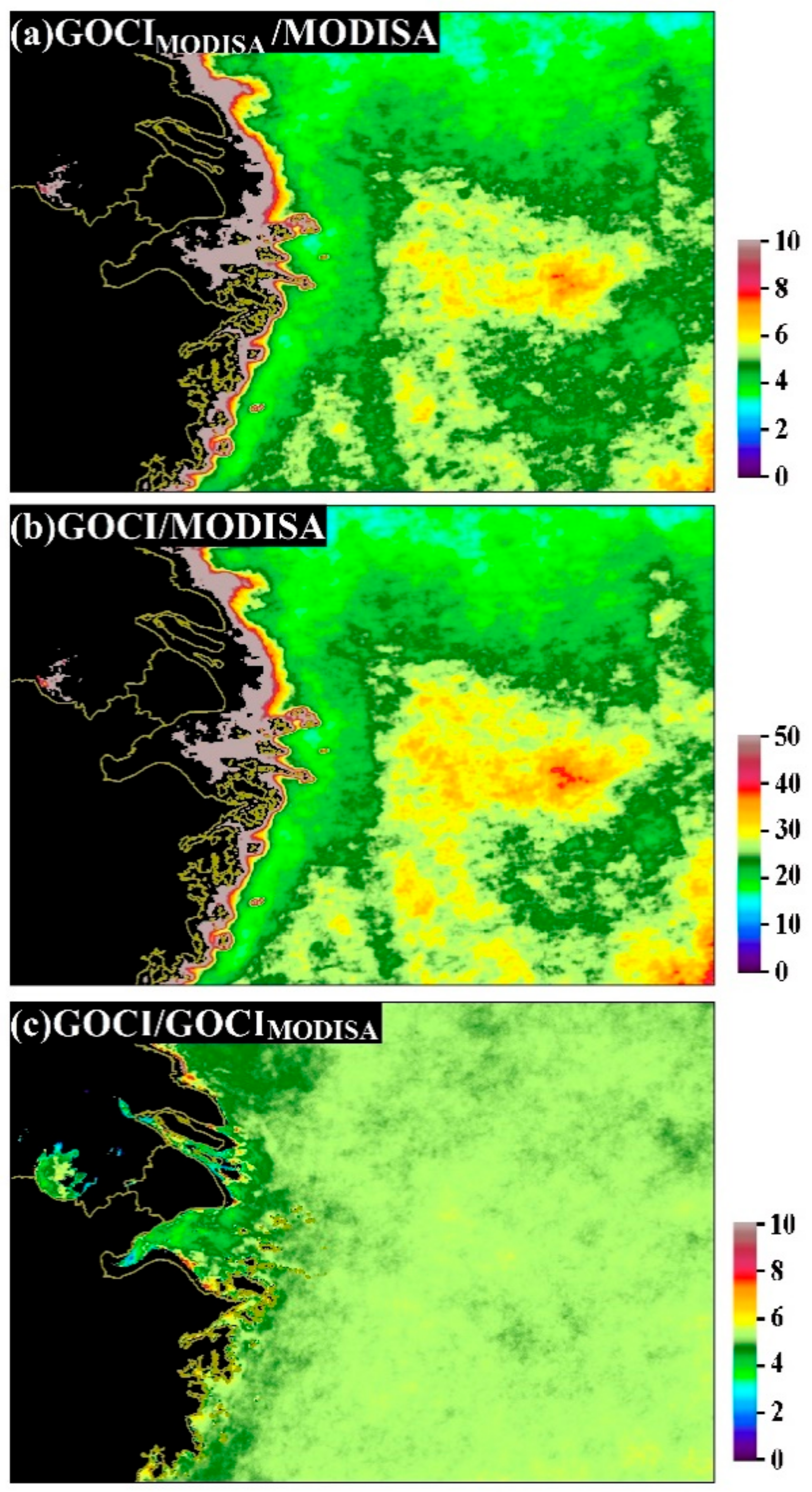


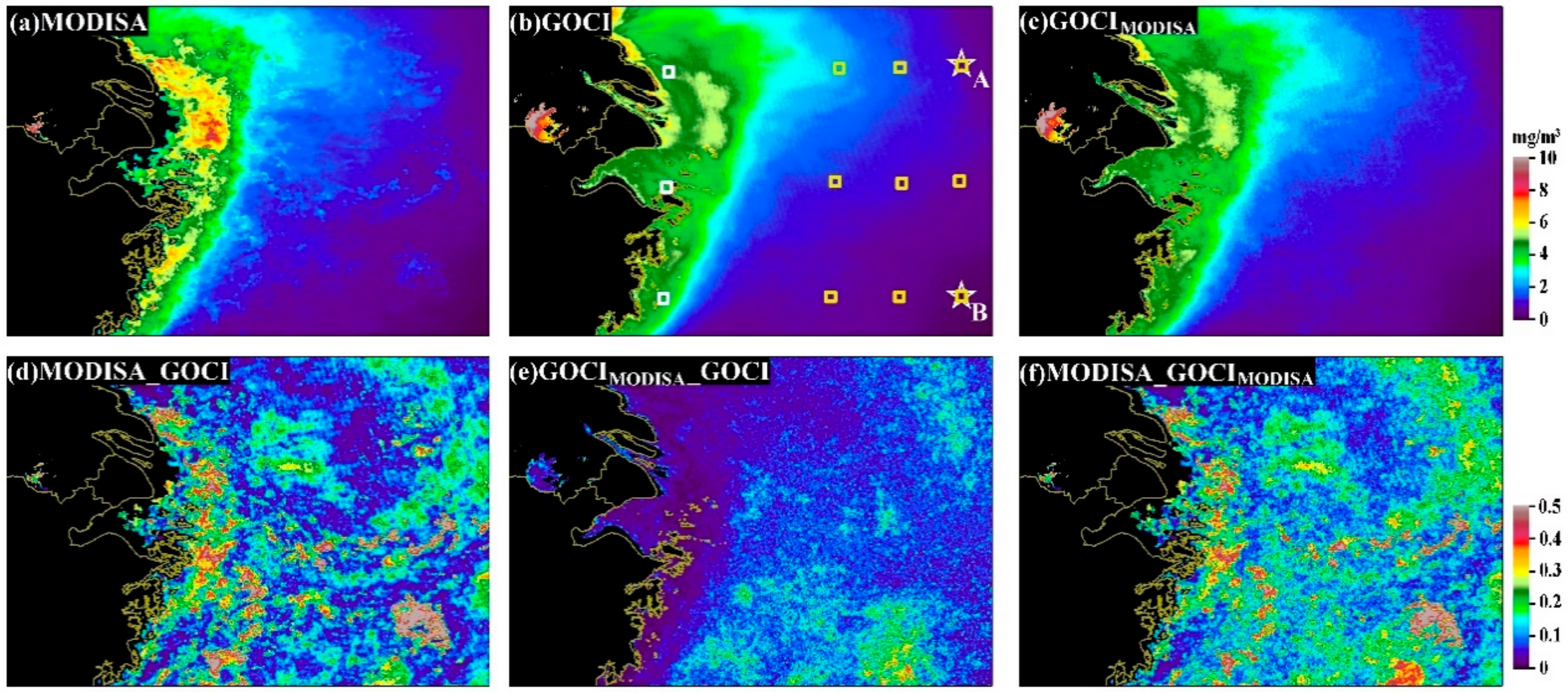

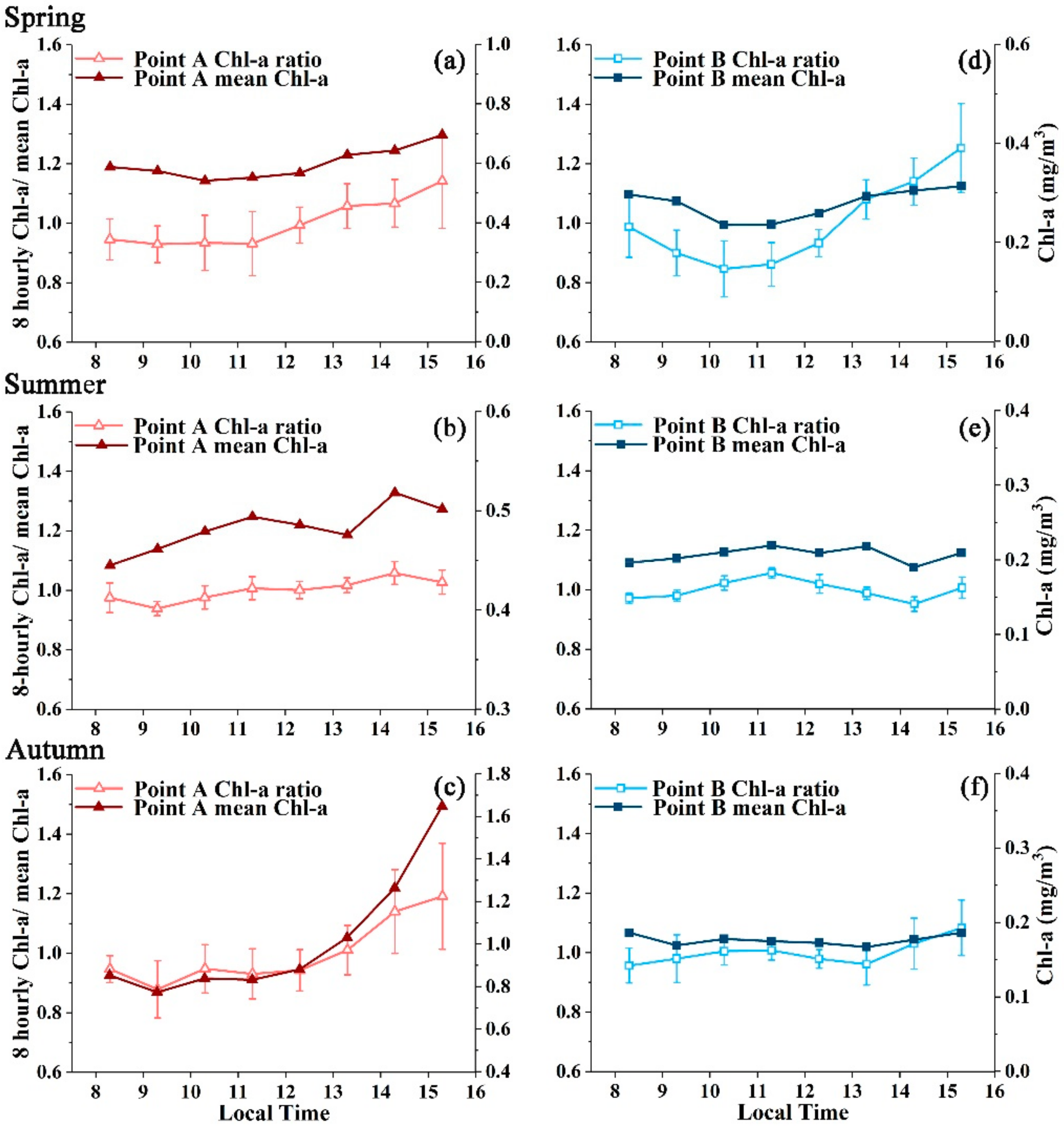
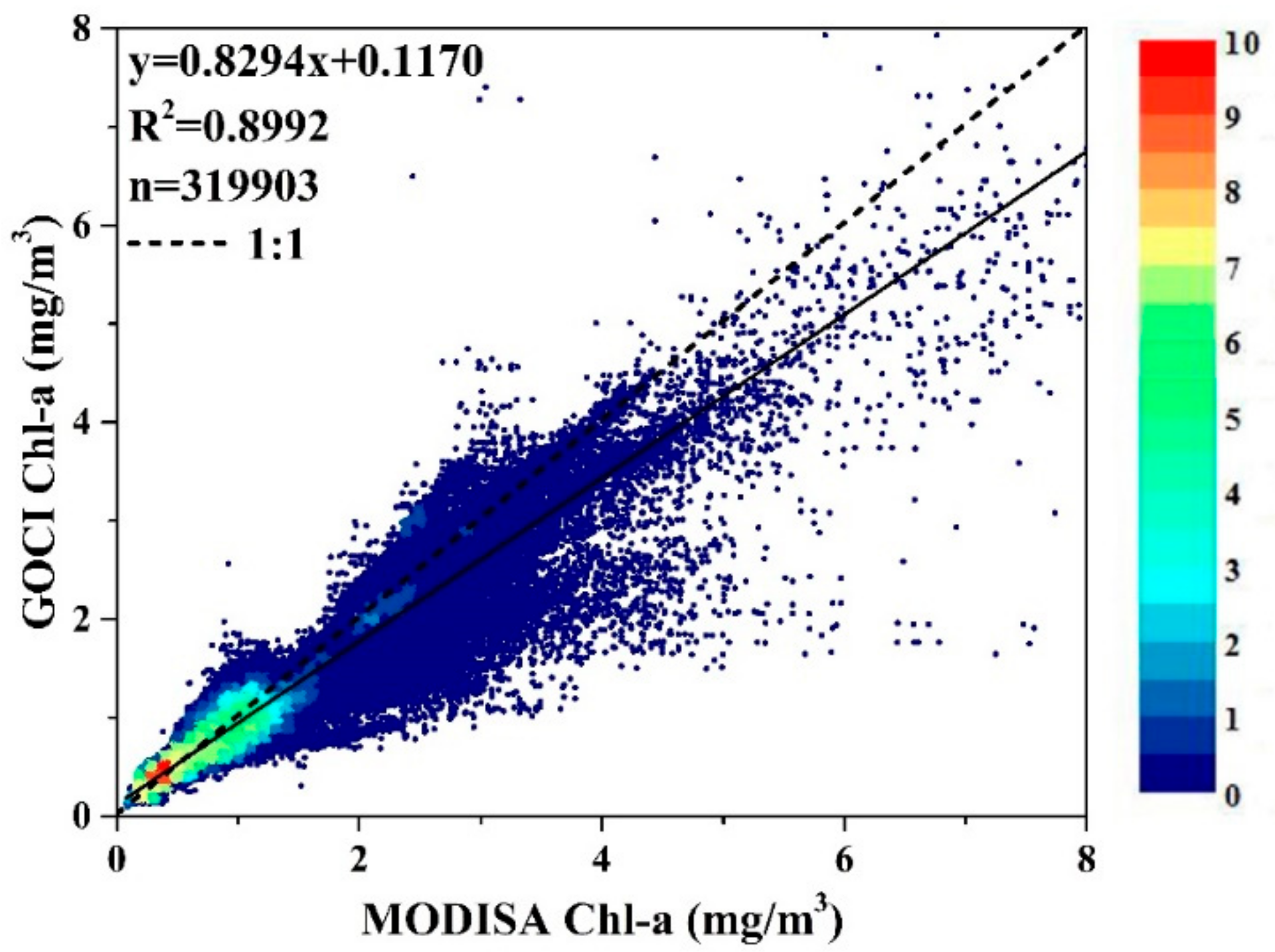
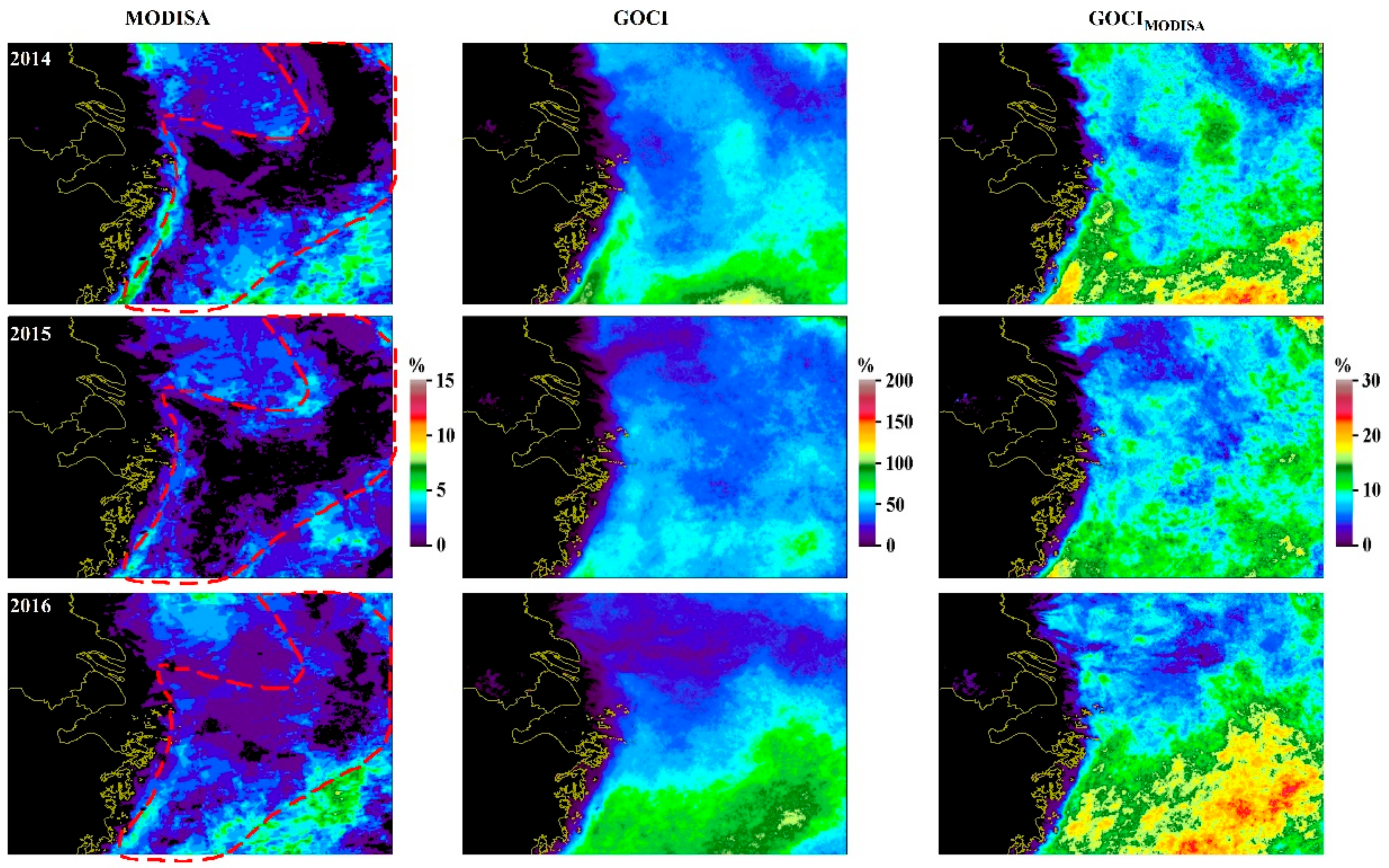
| Local Time | Point A | Point B | ||||||||||||||||
|---|---|---|---|---|---|---|---|---|---|---|---|---|---|---|---|---|---|---|
| Spring | Summer | Autumn | Spring | Summer | Autumn | |||||||||||||
| Chl-a Ratio | Ratio Std | Mean Chl-a (mg/m3) | Chl-a Ratio | Ratio Std | Mean Chl-a (mg/m3) | Chl-a Ratio | Ratio Std | Mean Chl-a (mg/m3) | Chl-a Ratio | Ratio Std | Mean Chl-a (mg/m3) | Chl-a Ratio | Ratio Std | Mean Chl-a (mg/m3) | Chl-a Ratio | Ratio Std | Mean Chl-a (mg/m3) | |
| 8:16 | 0.95 | 0.07 | 0.59 | 0.98 | 0.05 | 0.45 | 0.95 | 0.05 | 0.85 | 0.99 | 0.10 | 0.30 | 0.97 | 0.02 | 0.20 | 0.96 | 0.06 | 0.19 |
| 9:16 | 0.93 | 0.06 | 0.57 | 0.94 | 0.02 | 0.46 | 0.88 | 0.10 | 0.77 | 0.90 | 0.08 | 0.28 | 0.98 | 0.02 | 0.20 | 0.98 | 0.08 | 0.17 |
| 10:16 | 0.93 | 0.09 | 0.54 | 0.98 | 0.04 | 0.48 | 0.95 | 0.08 | 0.84 | 0.85 | 0.09 | 0.24 | 1.02 | 0.02 | 0.21 | 1.00 | 0.05 | 0.18 |
| 11:16 | 0.93 | 0.11 | 0.55 | 1.01 | 0.04 | 0.49 | 0.93 | 0.08 | 0.83 | 0.86 | 0.07 | 0.24 | 1.06 | 0.02 | 0.22 | 1.01 | 0.03 | 0.17 |
| 12:16 | 0.99 | 0.06 | 0.57 | 1.00 | 0.03 | 0.49 | 0.94 | 0.07 | 0.88 | 0.93 | 0.05 | 0.26 | 1.02 | 0.03 | 0.21 | 0.98 | 0.03 | 0.17 |
| 13:16 | 1.06 | 0.08 | 0.63 | 1.02 | 0.02 | 0.48 | 1.01 | 0.08 | 1.03 | 1.08 | 0.07 | 0.29 | 0.99 | 0.02 | 0.22 | 0.96 | 0.07 | 0.17 |
| 14:16 | 1.07 | 0.08 | 0.64 | 1.06 | 0.04 | 0.52 | 1.14 | 0.14 | 1.26 | 1.14 | 0.08 | 0.30 | 0.95 | 0.02 | 0.19 | 1.03 | 0.09 | 0.18 |
| 15:16 | 1.14 | 0.16 | 0.70 | 1.03 | 0.04 | 0.50 | 1.19 | 0.18 | 1.65 | 1.25 | 0.15 | 0.31 | 1.01 | 0.04 | 0.21 | 1.08 | 0.09 | 0.19 |
| Atmospheric Correction Failure | High Sunglint | Cloud Cover | High Solar Zenith Angle | Chlorophyll Algorithm Failure | High Sensor Zenith Angle | Straylight | High Radiance | DPVOs | Total Invalid Data | ||
|---|---|---|---|---|---|---|---|---|---|---|---|
| Inshore | MODISA | 0.04% | 0.04% | 54.92% | 0.00% | 0.00% | 18.37% | 7.15% | 18.50% | 0.65% | 99.04% |
| GOCI | 0.01% | 0.01% | 92.11% | 4.90% | 0.08% | 0.00% | 0.00% | 0.00% | 6.92% | 97.10% | |
| GOCIMODISA | 0.01% | 0.01% | 92.19% | 0.00% | 0.06% | 0.00% | 0.00% | 0.00% | 7.83% | 92.26% | |
| Offshore | MODISA | 0.00% | 0.00% | 50.06% | 0.00% | 0.01% | 16.72% | 16.90% | 14.67% | 3.31% | 98.37% |
| GOCI | 0.02% | 0.02% | 81.30% | 4.85% | 0.79% | 0.00% | 0.00% | 0.00% | 17.11% | 86.97% | |
| GOCIMODISA | 0.01% | 0.01% | 81.01% | 0.17% | 0.80% | 0.00% | 0.00% | 0.00% | 18.40% | 82.01% | |
| Within the tongue-shaped zone | MODISA | 0.00% | 0.00% | 53.84% | 0.00% | 0.00% | 17.06% | 12.58% | 15.73% | 0.37% | 99.22% |
| GOCI | 0.01% | 0.01% | 93.25% | 4.66% | 0.12% | 0.00% | 0.00% | 0.00% | 5.40% | 98.04% | |
| GOCIMODISA | 0.00% | 0.00% | 92.50% | 0.43% | 0.12% | 0.00% | 0.00% | 0.00% | 6.29% | 93.06% |
© 2020 by the authors. Licensee MDPI, Basel, Switzerland. This article is an open access article distributed under the terms and conditions of the Creative Commons Attribution (CC BY) license (http://creativecommons.org/licenses/by/4.0/).
Share and Cite
Zhao, D.; Feng, L. Assessment of the Number of Valid Observations and Diurnal Changes in Chl-a for GOCI: Highlights for Geostationary Ocean Color Missions. Sensors 2020, 20, 3377. https://doi.org/10.3390/s20123377
Zhao D, Feng L. Assessment of the Number of Valid Observations and Diurnal Changes in Chl-a for GOCI: Highlights for Geostationary Ocean Color Missions. Sensors. 2020; 20(12):3377. https://doi.org/10.3390/s20123377
Chicago/Turabian StyleZhao, Dan, and Lian Feng. 2020. "Assessment of the Number of Valid Observations and Diurnal Changes in Chl-a for GOCI: Highlights for Geostationary Ocean Color Missions" Sensors 20, no. 12: 3377. https://doi.org/10.3390/s20123377





